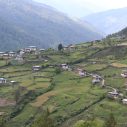
Search
María Emma Santos: ‘We reintroduced the question of how poverty should be measured on a global scale back into the global debate’

María Emma Santos is the co-author, along with Sabina Alkire, of the global Multidimensional Poverty Index (MPI), published by UNDP and OPHI since 2010. She is a researcher of the National Scientific and Technological Research Council of Argentina (CONICET), based at the Institute of Economic and Social Research of the South (IIES), Department of Economics, National University of the South (UNS), Argentina, and a research associate at OPHI at the University of Oxford.
The Multidimensional Poverty Index (MPI) marked a turning point in OPHI’s contribution to the debate on the measurement of global poverty. Could you tell us how this index came about?
The index was developed between 2009 and 2010. The year 2010 was approaching, marking 20 years since the publication of the first Human Development Report. Jeni Klugman, director of the United Nations Development Programme’s (UNDP) Human Development Report Office at the time, wanted the anniversary edition to be really special, for it to not only recognise the significant work carried out and progress made by the Human Development Report since 1990, but also for it to outline the new challenges faced, 20 years after the first report, with respect to the development of countries and the international agenda. I think that, essentially, she wanted it to become a kind of reference.
Klugman was in close contact with Sabina Alkire, director of OPHI. Sabina made many suggestions for the report so that it would offer new and better kinds of measurements with respect to both poverty and human development in general. OPHI was using the methodology proposed by Alkire and James Foster, which at the time Sabina wished to implement ‘on a large scale’. She wanted us to develop a multidimensional poverty index that, using the Alkire-Foster Method, would have the necessary content in terms of indicators to monitor progress in the reduction of multidimensional poverty in developing countries.
The challenge was a significant one: build and estimate a multidimensional poverty index that would be internationally comparable across 100 countries. That’s how we started working on it. It was a process that involved a huge amount of work and close interaction with the UNDP and many months and rounds of debates with experts. We had the normative guidance of the capability approach and the international development agenda set by the Millennium Development Goals (MDGs), but we were also held back by the limitations of data sources. We had to make many decisions, such as whether to include income or favour the inclusion of nutrition – in other words, to use the Living Standards Measurement Study (LSMS) or the Demographic and Health Surveys (DHS) and Multiple Indicator Cluster Survey (MICS) – and many other similar dilemmas. Can we include empowerment? What thresholds should we use? What weighting? It was a simultaneously fascinating and exhausting process. Sabina was very clear about where we were going with this. And I think we achieved our mission. We reintroduced the question of how poverty should be measured on a global scale back into the global debate. We stirred up the debate, in a good way, because it is always good to reconsider the question of what we want to measure and how we should measure it.
The MPI is ‘cross-sectional’ to many SDGs, not just the first one, and in this sense it is a multipurpose indicator. I think that seven years after its first edition, the MPI has become a reference that is an ideal counterpart to international monetary measurements of poverty.
What do you think are the main strengths of the index and what are its limitations?
I think that its main strength is its definition: measuring acute poverty in a direct way. It measures simultaneous deprivations, deprivations that form the core of poverty. A home considered poor by the MPI is undoubtedly poor. It is undeniable: at a minimum it has deprivations in all indicators related to living standards, which are mainly linked to housing (dirt floor, no access to treated drinking water, no improved sanitation facilities, lack of access to electricity, unclean energy used for cooking, and a lack of minimal durable goods). It could also be a home that has experienced infant mortality and where the children or women are malnourished. Or it could be a home that is totally deprived in education. Or it could be a combination of these factors. These homes suffer from acute poverty. They should be at the top of our list of priorities, no matter what.
As well as this direct identification (not indirect, as poverty by income is), the MPI lets us know what deprivations are experienced by the poor, and this is extremely useful from a policy point of view. It is a very important guide that provides information that can be used for clarification. This doesn’t mean that monetary poverty isn’t important. Income is important. We all like to have a minimum level of income because it gives us the ability to choose. But we also want a decent home and a minimum level of education and health. Often, access to a minimum level of income does not guarantee these functions for many reasons. From the point of view of those whose task it is to reduce poverty, knowing that the principal deprivations of the poor concern their home, education, or health, or concern all at the same time or some combination of these, is extremely important for informing policy.
I think the MPI has two limitations. On the one hand, the MPI measures intensity (how many simultaneous deprivations are experienced by the poor), but, given the nature of the indicators, they do not allow us to say much beforehand about the depth of each deprivation. This is more a problem with the kind of variables involved than a problem with the MPI per se. We know that it is worse to have to go and fetch water from the tap at the end of the street than to have a tap in your house, but it is difficult to say how much worse it is. In any case, there are ways, and in fact OPHI uses them, to tell this story too. Different thresholds can be used and can identify the destitute, something that Sabina has worked on with Suman Seth.
The other limitation is that, although it is multidimensional, the MPI cannot take everything important into account. This is partly due to the available data: there are many relevant indicators for which there is no internationally comparable information available. However, I don’t think that this would be feasible either. One index of 20 indicators would end up undermining the MPI. The MPI monitors acute poverty. If we want to evaluate poverty with more demanding standards, then we can use the national MPI or a regional MPI, such as those we have developed for Latin America with colleagues from the Economic Commission for Latina America and the Caribbean (ECLAC).
The MPI recently turned seven years old. How do you see its future as a measure of international comparison for poverty?
I think it has a big future. The 2030 Agenda is extremely demanding. It is wonderful that it exists. It is a magnificent ‘goal’, but monitoring it will not be easy because there are many objectives and aims, and therefore many indicators, which in some cases are more demanding than those in the MDGs. The MPI summarises a lot of information in one number, and it can also then ‘unpack’ this information with its indicators. Furthermore, the MPI is ‘cross-sectional’ to many SDGs, not just the first one, and in this sense it is a multipurpose indicator. I think that seven years after its first edition, the MPI has become a reference that is an ideal counterpart to international monetary measurements of poverty
Published in Dimensions Special Issue – June 2018
















